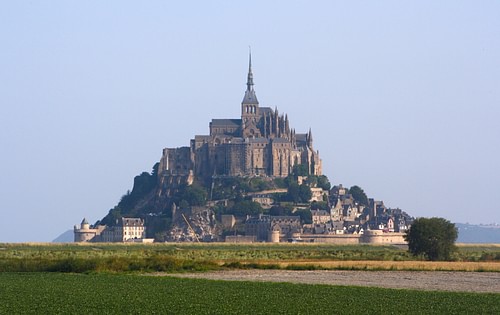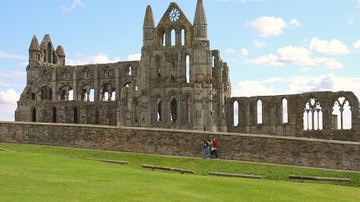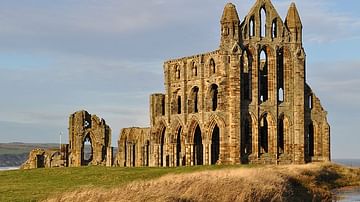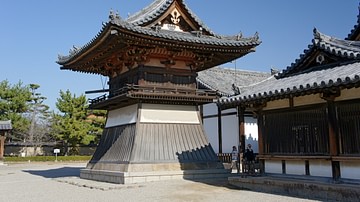
Mont-Saint-Michel is the name of a tidal island located off the coasts of Normandy and Brittany, near the mouths of the Couesnon River and the town of Avranches in France. While the island of Mont-Saint-Michel has held cultural, religious, and strategic value since the Merovingians held power over the region, Mont-Saint-Michel is universally recognized today as the site of a beautiful Gothic-style Benedictine abbey, which was constructed from the 11-16th centuries CE and dedicated to the Archangel St. Michael. Aptly called the “Wonder of the West", Mont-Saint-Michel and its bay were designated a UNESCO World Heritage Site in 1979 CE, and the island's abbey is one of France's most popular sites with over 3 millions visitors per year.
Geography & Early History
The island of Mont-Saint-Michel is situated 1 km (0.6 miles) off the northwestern coast of France and it is situated 66 km north of Rennes and 52 kilometres east of St. Malo. Mont-Saint-Michel covers an area of only 7 ha (17 acres) in area, and the island's circumference covers some 960 m (3,150 ft) while its tallest point is 92 m (302 ft) above sea level. Mont-Saint-Michel is a tidal island, meaning that it was once connected to the French mainland. The tides in and around Mont-Saint-Michel are among the most dramatic in Europe - they can vary by as much as 15 m (49 ft) depending on the time of year and prevailing weather conditions. In the Middle Ages, pilgrims had to cross 7 kilometers (4.3 miles) of water in order to reach the island, which is a full 5 kilometers farther out into the English Channel than it is today. The crossing itself could be a deadly enterprise as one had to wait until low tide, and only then could pilgrims traverse the mud to reach Mont-Saint-Michel. (In 1318 CE, 30 pilgrims died when trying to reach Mont-Saint-Michel, and in modern times, organized rescues of tourists and pilgrims remain alarmingly common.)
The early history of the island is shrouded in the mists of mystery, but it is known that the island was known as Mont Tombe (Latin: tumba). In the Middle Ages, the faithful believed that St. Aubert of Avranches (d. 720 CE) was the first to erect a Christian sanctuary on Mont Tombe and dedicate it to St. Michael the Archangel. Legend states that St. Aubert, who was then the bishop of Avranches, had a vision in which he saw the Archangel Michael. In his vision, the Archangel told him to oversee the construction of a small oratory on an island near the terminus of the Couesnon River. The Archangel continued to appear to St. Aubert until he promised to build the oratory. Other traditions attest that before St. Aubert, Irish or Welsh monks established a small hermitage on the island in or around the 6th century CE.
Historical evidence for Mont-Saint-Michel, however, is only apparent from the mid-9th century CE onwards. It is referred to in various hagiographical works as a place popular with pilgrims, and the account of its foundation lies in the "Revelatio ecclesiae sancti Michaelis." Mont-Saint-Michel's founding date - 708 CE - comes from chronicle written at Mont-Saint-Michel in the 1100s CE, and there is no good authority for its establishment by St. Aubert either. It is likely that Mont-Saint-Michel functioned primarily as a Breton monastery in the Early Middle Ages until roughly the 11th century CE when it came under the control of the Normans. Curiously, Mont-Saint-Michel only appears in Norman charters in 1009 CE. This again leads credence to the belief that there was an enduring and strong influence from the neighboring Duchy of Brittany exerted on the religious community at Mont-Saint Michel.
Norman domination of Mont-Saint-Michel commenced in 966 CE when Lothair I of France (r. 954-986 CE) gave the orders for the issuing of a charter on Mont-Saint Michel, specifying Norman interests and dominance in the establishment of a Benedictine community on the island. The Benedictine monks, under the watchful eyes of Richard I (r. 942-996 CE), Duke of Normandy, managed their monastery well, stimulating Mont-Saint-Michel's growth as a major center of pilgrimage and also as a place of commerce. The Benedictine monks produced a large number of manuscripts and books on the island, which in turn gave Mont-Saint-Michel the adage "The City of Books." In the course of the 11th Century CE, Norman rulers (and after 1066 CE the kings of England) began to see Mont-Saint-Michel as a place of faith as well as a strategic fortress due to the increased rivalry with Capetian France. Mont-Saint-Michel received a military garrison, which was put at the disposal of both its abbot and the Norman and Plantagenet kings of England.
Mont-Saint-Michel's fame and fortunes grew steadily from the 11th-15th centuries CE, as the Normans established a Romanesque abbey church in the late 11th century and later expanded this church in the 12th century CE. Although Mont-Saint-Michel endured heavy damage as a result of a successful siege led by Philip II of France (r. 1180-1222 CE) in 1203 CE when he captured Normandy from England, his generous patronage of the mount facilitated the construction of a beautiful monastery known as "The Wonder" (French: "La Merveille.") This building is perhaps the most lovely on Mont-Saint-Michel for it is a veritable masterpiece of late Norman-Gothic engineering and art. (It consists of two buildings that are three stories high, a refectory, and an immense cloister.) King Louis IX (r. 1226-1270 CE) visited the Abbey and patronized it further with royal gifts and the order for the renovation of its defensive walls and other military structures.
Later History
During the Hundred Years War (1337-1453 CE) between England and France, the English besieged and blockaded Mont-Saint-Michel three times. The French had built strong walls in the 13th century CE that would enable it to withstand a 30-year long siege by the English. The Abbey withstood the deprivations that came from the sieges, and Mont-Saint-Michel was the only part of western and northern France to avoid occupation by the English during the Hundred Years War. Following the Hundred Years War, the abbots at Mont-Saint-Michel became commendatory abbots in 1442 CE, whereby they held the Abbey "in commendam," drawing from Mont-Saint-Michel's resources and revenues but not holding authority over the Benedictine monks in terms of rules and regulations. Mont-Saint-Michel thus entered a period of relative decline, which continued over the course of the French Wars of Religion (1562-1598 CE). Gabriel, comte de Montgomery (1530-1574 CE) laid siege to Mont-Saint-Michel, but was defeated. The Abbey never fell under the control of the Huguenots and was thus spared the ravages of Protestant iconoclasm.
Mont-Saint-Michel's fortunes became increasingly dire in the 18th century CE; there were only seven monks in residence when the Abbey was dissolved during the French Revolution (1789-1799 CE). Napoleon I (r. 1804-1815 CE) ordered that Mont-Saint Michel become a prison, and it remained so until the 1860s CE. Restoration work began in earnest in 1874 CE, and Catholic worship returned to the island in 1922 CE. The Abbey was returned to the Benedictine order in 1966 CE to mark 1,000 years since its establishment, and Mont-Saint-Michel and its bay became a UNESCO World Heritage Site in 1979 CE. A new bridge replaced an old causeway to better suit the natural tidal flow and the Couesnon River.
Abbey Architecture
Mont-Saint-Michel's Abbey church encompasses an 11th-12th century CE Romanesque nave as well as a choir built in French Gothic style during the 15th and 16th centuries CE. A statue of St. Michael the Archangel sits atop the Abbey's spire some 91 m (300 ft) in the air, and the Abbey's church is situated on top of three crypts that date from either the Merovingian or Carolingian epochs. Thanks to the efforts of Philip II and Louis IX of France, Mont-Saint-Michel's defensive and exterior walls afford remarkable views of the southern and eastern sides of the mount. On the island of Mont-Saint-Michel are also the refectory, the luxurious cloister, and winding medieval streets.







